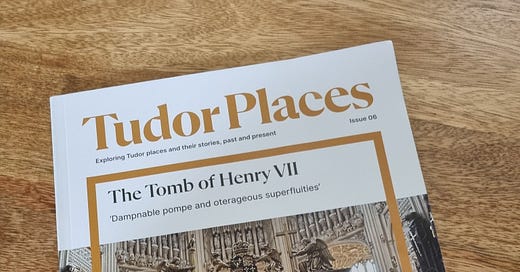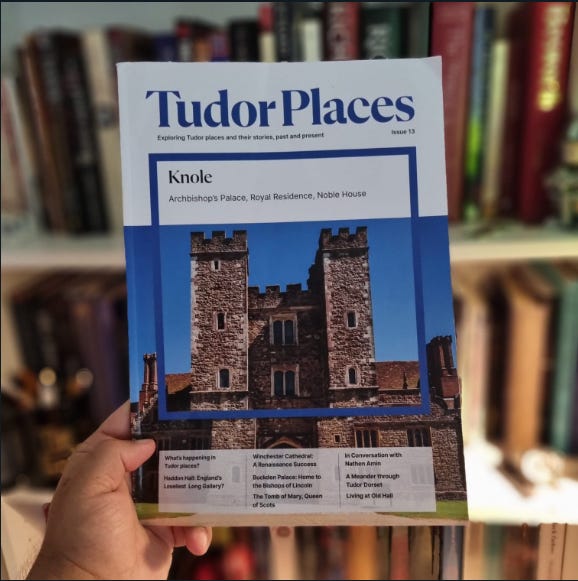Tudor Places - the must-have magazine for Tudor aficionados
"Perfect for people who love history and the places where history happened"
Tudor Places is a SUPERB publication, one that must be on every Tudor aficionado’s subscription list.
Since it was launched in May 2022 by author and historian Deborah Roil, one half of the also-excellent Tudor Times platform, this beautifully produced and colourful magazine has become a genuine must-have for those of us who just LOVE visiting the places the Tudors, both the dynasty and those living under them, walked.
Each issue features an array of articles, features and interviews that look at the whole Tudor world in depth, with, as the name suggests, particular emphasis on those places we can still visit and experience today. Among regular contributors are Tracy Borman, Kirsten Claiden-Yardley, Siobhan Clarke, Alfred Hawkins, Julian Humphrys, Sarah Morris, Elizabeth Norton, Nicola Tallis, Melita Thomas, Brigitte Webster, Emma Wells, plus many more! As their mission statement reads, ‘perfect for people who love history and the places where history happened’.
I have had the honour of featuring in Tudor Places multiple times now, spreading my love of Welsh sites associated with our most famous royal dynasty, with more plans to feature again in future. Articles I have already written for Tudor Places are:
Tenby – the most important Tudor town? (Issue 1)
The Rise and fall of Harlech Castle (Issue 3)
Carew Castle (Issue 6)
The Tudors: Made in Brittany? (Issue 8)
In the most current issue, number 13, I was interviewed by Tudor Places about all things history, and my writing, and I’ll share some questions and answers below:
What is your approach to writing historical non-fiction? Do you do all the research, before you begin writing, or do you write as you research?
I tend to skim-read some of the most authoritative non-fiction accounts about the subject I am writing about, just to get a feel of the subject, and to jot down a basic chapter plan, making sure the key events are covered.
Each chapter, I know roughly the story I want to tell, from beginning to end. I then write that story in free-form, from the top of my head, again often using secondary sources to guide me. It is then I go to work on primary sources which can take months for each chapter, at which point I can often see why history has created a consensus or where I feel historians have misunderstood the source which can change the entire chapter’s shape. And then edit. And edit.
My books take four years to write and each chapter goes through intensive rewrites as the entire book takes shape and new sources are uncovered as I progress. I think most writers will naturally come to a style that works for them. I look at my writing as a TV series – each chapter is an episode and I need to make sure the start and ending are gripping to keep the viewer watching.
What do you enjoy most about your work as an author and historian?
I love seeing the organisation and planning all come together as the work progresses, when I have a clear mission in what I want to convey to the reader and it starts to take shape. But nothing can compare to giving public talks, meeting the readers and signing your book for them to read. I wished everyone could feel how great that feels.
What is your favourite Tudor place, or places, and why are they your favourites?
Too many to choose from! I will always love Raglan Castle, both for the majestic, and unique, ruin it is today and for its deep association with the life of Henry VII. It is very evocative standing atop the huge Great Tower at Raglan, looking down on the wonderful French-inspired gatehouse and beyond that across the Brecon Beacon mountain range, thinking about Henry’s childhood here, the only stable period of his life until he became king at 28.
Tudor Places ships worldwide, so geography isn’t a barrier to you receiving the magazine, and if you subscribe, you even save money on each issue. In fact, subscribers even get a free guide of 35 places in London with Tudor Connections. You can also buy individual issues. This is sounding like an advert, but it’s not, it’s just one fan telling my following about something I love. Anyway, check them out by HERE
Son of Prophecy in the US or Rest of the World
Remember, if you are based outside the UK, you do not need to many months for ‘Son of Prophecy: The Rise of Henry Tudor’ to be released in your country. A UK bookseller called Blackwell Books ships WORLDWIDE for free of charge. So to get your copy early, head HERE to order.
Upcoming Events
The hustle never stops once a book is released, and one of the most fun parts of book promotion is hitting the road, talking to readers in person, signing their books and answering their questions. I have some upcoming talks, which are shown in the image. To book your spot, click HERE for more details
Vera Update
And finally, in Vera update, there is no real update. She continues to WASTE her summer sleeping, sleeping, AND sleeping. But she does look comfy, doesn’t she?










Your writing process is very like the one some of us historical fiction writers favor. As you write nonfiction, I'm curious if and how often that initial first draft story changes as you move into the next research phase. Do you make new discoveries that change your mind or do you find your initial story is usually confirmed?
Thanks for sharing this - it’s a great insight into your work as a history writer.